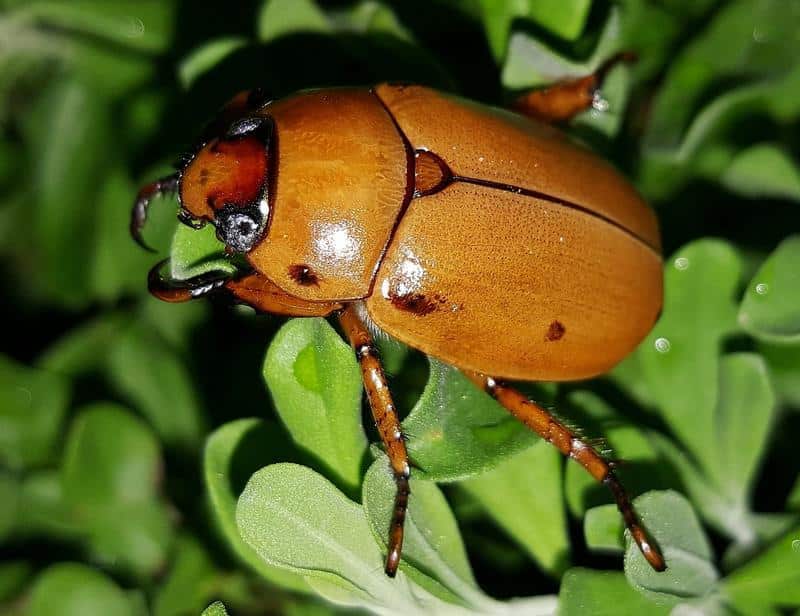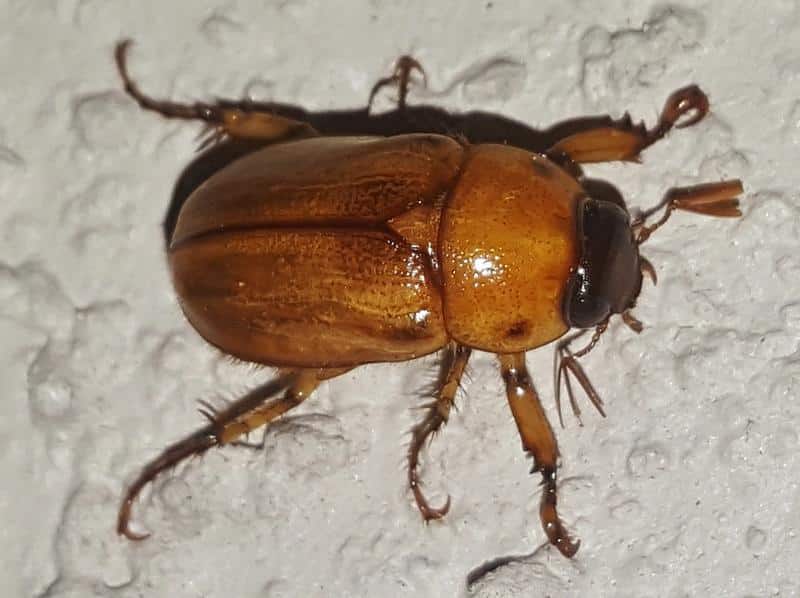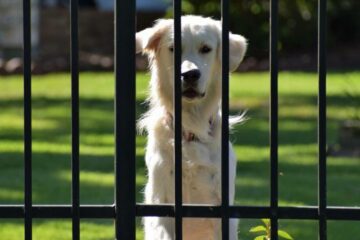Are June Bugs Poisonous to Dogs? Can Dogs Eat June Bugs?
Are June bugs poisonous to dogs? Can dogs eat June bugs? In this article, we’ll tell you everything you need to know about these questions. That includes what to do right away, and also the command you’ll need to prevent are future issues with your dog eating June bugs.
We’re also going to cover the other questions you have, like where do June bugs live during the day, where do June bugs go in the winter, how long do June bugs live, and of course, how to get rid of June bugs naturally so you won’t put your dog’s safety at any risk. Keep reading!
Are June Bugs Poisonous to Dogs?

June bugs are not poisonous to dogs. If your dog happens to munch on one or two of these insects, it should not cause any serious harm. However, excessive consumption can potentially lead to gastrointestinal upset. Always keep an eye on your pet and encourage them to avoid these critters.
Are June Bugs Toxic to Dogs?
June bugs, also known as May beetles or June beetles, are not inherently toxic to dogs. However, like any foreign body, consuming them in large quantities can cause discomfort or gastrointestinal upset. There are also rare cases where a dog may have an allergic reaction to a June bug.
If your dog has eaten a large number of these insects and exhibits signs of distress, contact your vet immediately.
June Bugs and Dogs
While June bugs themselves are not toxic, they can cause problems if ingested in large quantities. Your dog may experience symptoms such as vomiting or diarrhea due to the indigestible wings and exoskeletons of the bugs.
Furthermore, there is a risk of internal blockages if your dog eats a large amount of these insects. Also, it’s worth noting that while the bugs themselves aren’t harmful, they could potentially carry pesticides or other toxins if they’ve been in contact with treated plants.
How to Train the “Leave It” Command
One effective way to discourage your dog from eating June bugs is by teaching them the “leave it” command. This command tells your dog to ignore the item they’re focused on.
- Start by holding a treat in both hands. Show your dog one closed fist with the treat inside, and say, “leave it.”
- Let them lick, sniff, mouth, paw, and bark to try to get it — ignore these behaviors.
- Once your dog stops trying, give them the treat from the other hand.
- Repeat until your dog moves away from that first fist when you say, “leave it.”
- Next, only give your dog the treat when they move away from that first fist and also look up at you.
By consistently practicing this command, you can train your dog to avoid June bugs and other potentially harmful items. As with any training, you need to be patient, consistent, and reward your dog for good behavior.
But while these steps will get your dog to stop eating June bugs, it’s important to remember that the underlying behavioral issues (prey drive, curiosity, overexcitement, etc.) that were causing all of this to begin with will still be present. And until you address those, any positive changes you see are only going to be temporary.
“Well, how do I make these changes last?”
By getting your dog to truly choose to follow your direction, that’s how. I tried many times to write out how you can do that before deciding it made more sense to just link you to the free video series that explains it better than I’d ever be able to.
The series is by a man named Dan who is one of the world’s leading dog obedience trainers. In it, he teaches you how to put an end to things like when your dog eats June bugs and all other misbehavior using his fast and easy-to-follow methods.
In the first video, Dan will reveal to you why the two most common methods of dog training only doom you to failure. You can watch the video now by clicking here. Follow the proven system he’ll show you in his series and you’ll never have to spend another second worrying about your dog eating June bugs ever again!
Can Dogs Eat June Bugs?

Dogs should not eat June bugs. While June bugs aren’t poisonous to dogs, they’re not a good snack either. If your dog catches and eats one or two June bugs, it’s generally not a cause for alarm, but consuming them in large amounts may lead to gastrointestinal upset, such as vomiting and diarrhea. It’s best to keep your dog from eating these insects if possible.
Dog Eating June Bugs
Some dogs are naturally intrigued by moving objects and may be drawn to the buzzing, fluttering movement of June bugs. However, while it’s generally safe for dogs to eat a few June bugs, consuming these insects should still not be done as it is not without risks.
June bugs have hard exoskeletons that can be difficult for dogs to digest, and eating a large number of them may lead to indigestion or even a blockage. If you notice your dog eating June bugs, it’s a good idea to distract them with a game or a favorite toy and move them away from the area. Learn the command that will help in the first section.
Are June Bugs Bad for Dogs?
June bugs are not bad for dogs inherently. However, potential problems can arise if your dog eats them in large quantities. The exoskeleton of June bugs is hard to digest and, if consumed in excess, can lead to gastrointestinal blockages.
Additionally, June bugs could be carrying pesticides or other harmful substances if they’ve been in an area treated with these chemicals. While a single bug might not cause harm, repeated exposure to these toxins can have detrimental effects on your dog’s health.
Why Does My Dog Eat June Bugs?
Dogs are curious creatures and many are attracted to the movement of bugs. The fluttering of June bugs might stimulate your dog’s prey drive or curiosity. Also, some dogs might just find the taste of these bugs appealing.
It’s important to remember, though, that eating bugs can expose your dog to potential health risks. If your dog is eating June bugs frequently, go back to the first section now where we’ll teach you the command and other things you should know to stop this behavior once and for all.
You’ll want to get this taken care of now as it will keep your dog safe during other future interactions. You then won’t have to worry about praying mantis being dangerous to dogs, what to do if your dog ate a dragonfly, how to handle fire ant bites on dogs, or if your dog can eat Japanese beetles, because you’ll know your dog will behave.
Where Do June Bugs Live?

June bugs, also known as June beetles, are found in various regions worldwide, particularly in North America. They spend most of their life cycle in the ground as grubs before emerging as adults. During the day, June bugs are typically hidden away, but at night, they become active, seeking out food and mates.
In winter, they burrow underground for protection from the cold. An adult June bug’s lifespan is typically around 2 to 3 years. Let’s delve deeper into the lives and habitats of June bugs.
Where Do June Bugs Live During the Day?
June bugs are nocturnal insects, meaning they are most active during the night. During the day, they seek shelter in cool, dark places. They often hide in shrubs, trees, or under leaf litter to avoid the harsh sunlight and predators. When dusk falls, June bugs emerge from their hiding places to seek out food, which primarily includes leaves and flowers, and to search for mates.
Where Do June Bugs Go in the Winter?
During the winter months, June bugs are in their larval stage, also known as “white grubs.” They burrow deeper into the soil below the frost line to survive the colder temperatures. Here, they enter a state of dormancy or slowed metabolic activity, which is often likened to hibernation.
As the soil warms up with the arrival of spring, the grubs become more active, feeding on the roots of plants and continuing their development until they emerge as adult beetles in late spring to early summer.
How Long Do June Bugs Live?
The life cycle of a June bug is generally two to three years. Most of this time is spent in the soil as a grub, developing from an egg into a mature beetle. The adult June bugs, which are familiar to most people, have a relatively short life span, typically only living a few weeks to a couple of months.
After they mate and lay eggs, the adult beetles die off, and the cycle begins anew with the hatching of the eggs.
Learn the command you need to keep your dog safe around June bugs by going back to the first section.
How to Get Rid of June Bugs Naturally
Getting rid of June bugs naturally from your yard involves a few strategic steps: employing natural predators, modifying the habitat, using botanical insecticides, and trapping adults. These methods are safe for dogs and can efficiently eliminate June bugs from your surroundings.
- Natural Predators: Attracting natural predators to your yard can play a significant role in controlling the population of June bugs. Birds are an excellent predator of these bugs. Attract more birds by setting up bird feeders or bird baths, and planting native plants which provide food and shelter.
Similarly, amphibians like toads and frogs are natural hunters of June bugs and can be drawn in by creating small ponds or damp areas in your garden. Beneficial insects, such as ladybugs and praying mantises, are also potent predators and can be attracted by growing a variety of flowering plants. - Habitat Modification: Make your yard less appealing for June bugs to lay eggs and for their larvae to thrive. Regular lawn care practices like aerating and fertilizing your lawn can encourage a healthier and more robust lawn, which in turn discourages the grubs from infesting.
Be careful with watering—overwatering your lawn can make it an attractive spot for female June bugs to lay their eggs. Keeping your yard free of excess organic matter can also deter these bugs. - Botanical Insecticides: There are several natural, non-toxic insecticides available that can deter adult June bugs from infesting your yard. Neem oil, for instance, can be used as a soil drench, killing the grubs without causing harm to beneficial insects or your dogs.
Insecticidal soaps are another effective solution. They work by suffocating the bugs and are harmless to pets and humans. - Trapping Adults: Trapping is a simple and effective method to control adult June bugs. You can create a simple trap using a white light and a bucket of water. Set the light over the bucket in a way that it shines into the water. June bugs, like many insects, are attracted to light sources.
The theory is that they mistake the light for the moon and stars, which they use as navigation tools. When they move towards the light, they end up hitting the water surface, where their exoskeleton gets wet, making it impossible for them to escape, causing them to drown.
This method is a non-toxic and highly effective way of reducing the adult June bug population in your yard.
In summary, getting rid of June bugs naturally entails drawing in natural predators, making your yard less inviting, using botanical insecticides, and trapping adults. It’s an environmentally friendly and pet-safe approach to maintaining a June bug-free yard. Learn the command that will keep your dog safe around them by going back to the first section.
I’m sure you’re ready to have all of these problems with June bugs and dogs behind you, so I’ll let you get started on everything now. Good luck, and thanks for reading our article “Are June Bugs Poisonous to Dogs? Can Dogs Eat June Bugs?”





